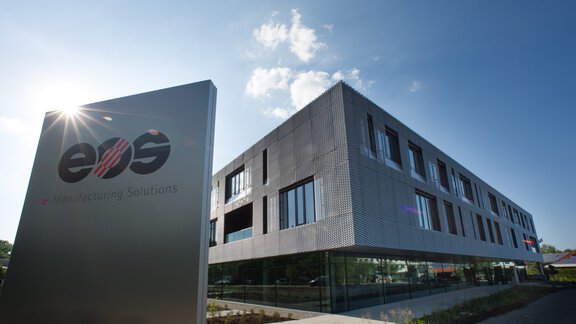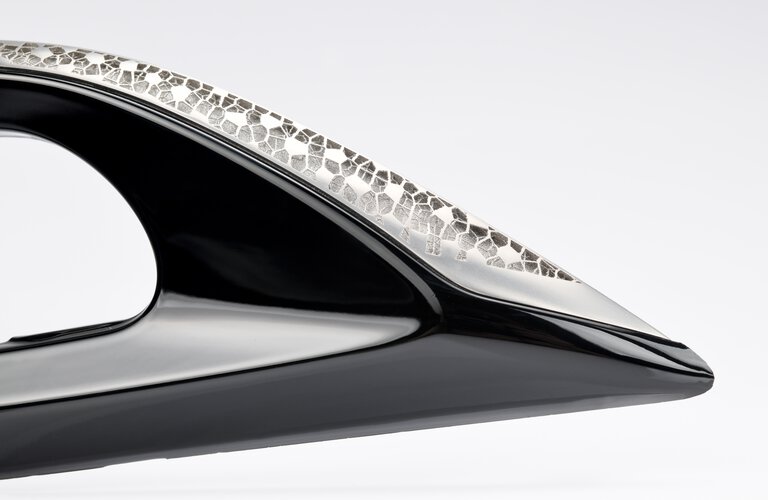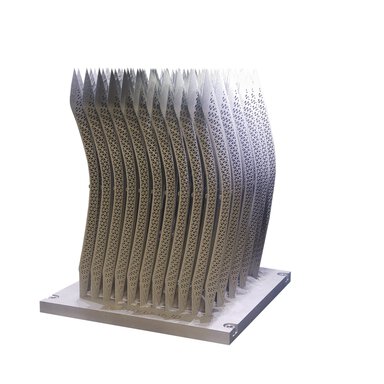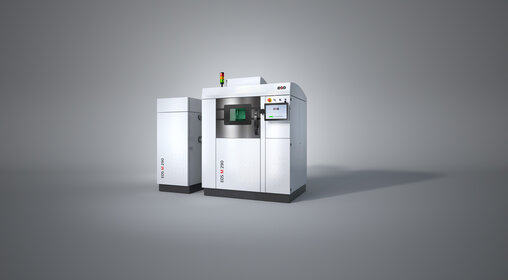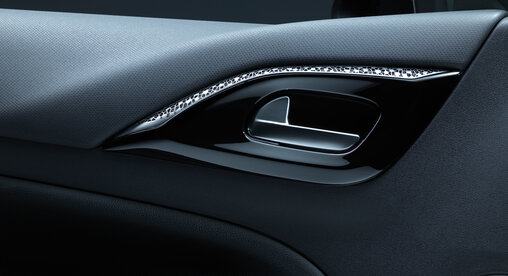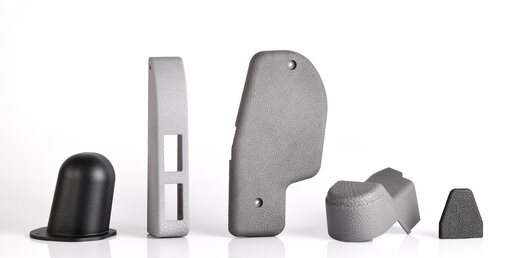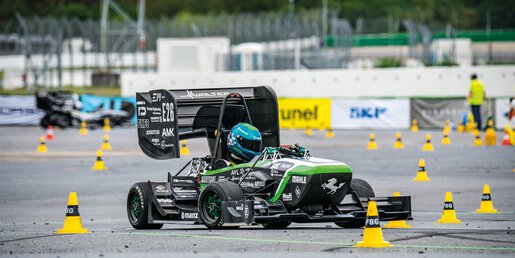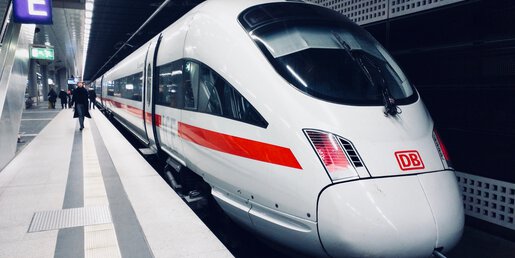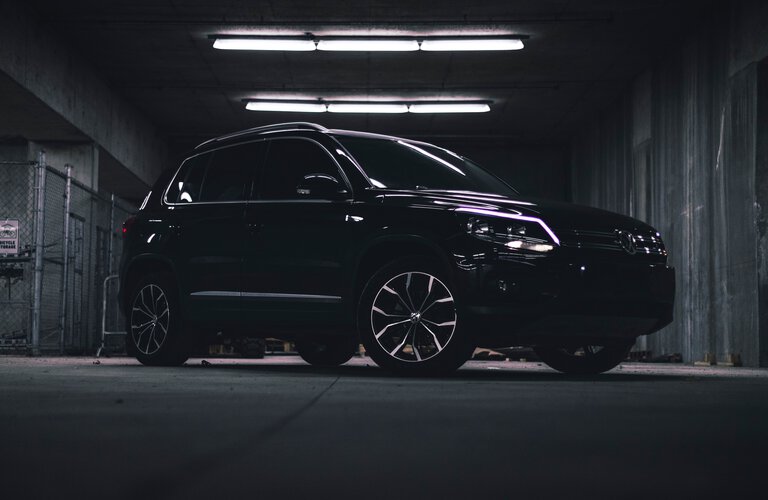DS 3 Dark Side Limited Edition – Advanced Innovation Through Additive Manufacturing
In the automotive sector, limited editions of successful models are a smart marketing move. But car makers are always looking for specific ways to distinguish themselves from their competitors within their market segments. DS Automobiles, a brand by the PSA Group, managed to establish itself on the premium segment within a few years thanks to a series of iconic models. The compact DS 3 model has received widespread recognition throughout this segment, with limited edition models being unveiled on a regular basis. For the Dark Side edition, DS Automobile wanted to go further than the usual equipment by including 3D printed parts to highlight their continuous dedication to innovation. Additive manufacturing gave complete creative freedom to the DS design team, as well as very fast and easy implementation and production thanks to Spartacus3D experts working with an EOS M 290 machine.
It's been a tremendous project from start to finish, as exciting as it was challenging for our expertise. We are excited to imagine that all these cars are now all over the world. And throughout all of this project, we knew we could count on reliability, quality and support from EOS.
Challenge
Manufacture high-quality accessories for DS 3 limited edition cars with unique designs and swift time-to-market
The project started when the DS Design team began looking for innovative enhancements to the interior of the DS 3 limited edition. The accessories needed to highlight the car maker's constant search for innovation and while satisfying the highest standards of quality demanded by the premium segment. From the very beginning, the designers decided to leverage the potential of additive manufacturing to present a world premiere in this field. Additive manufacturing opens up brand new design possibilities;
DS Automobiles presents several limited editions for the DS 3 every year, so having these new options is a real game changer for the team. The design team also chose titanium, a material which gives a luxury touch, is resistant and enables an easy and good-looking finish.
But while 3D printing is commonly used in the automotive sectors for prototyping, serial production with additive manufacturing is still very rare, especially for metal parts. Therefore, DS Automobiles had to find a partner with both additive manufacturing expertise and enough production capacity to accommodate their volume requirements. The objective was to deliver around 700 cars onto the markets worldwide. The project also had a limited development time frame to match the production planning of the car, with very precise targets in terms of go-to-market.
Each limited edition has a specific price target, so all additively manufactured parts must fit into the overall budget. The investigation phase resulted in the choice of two parts: the door handle and the key holder.
Spartacus3D, a subsidiary of the French material transformation group Farinia, met all these requirements: having used 3D printing for years, the company has very deep knowledge of additive manufacturing to help them translate the designs provided by the DS team into production. With their EOS M 290 machine and EOS Titanium Ti64, Spartacus3D possessed all the skills needed to meet the design and quality requirements that DS Automobiles was striving toward, as well as the production and post-treatment capacities required to deliver the project on time.
Solution
Series production of the parts on an EOS M 290 in EOS Titanium Ti64
The DS design team used an innovative parametric design to create the inside door handle covers and the electronic key holder detail in a very intricate titanium mesh, highlighting the innovation and quality dedication of DS Automobiles.
In order to find the best compromise between quality, cost and design, many iterations were necessary between the DS design team and Spartacus3D. This included the manufacturing of several prototypes, something that additive manufacturing makes particularly easy to perform in a single production batch.
As part of this process, the DS design team also selected the finish of the parts; they ultimately settled on an attractive matte finish obtained by manual polishing. The quality team defined precise acceptance criteria for the distortion, surface quality (e.g. porosity and shine), and cutting edges. In parallel to this back-and-forth, Spartacus3D also worked on optimizing the production of the parts; in order to reduce the costs, Spartacus3D not only needed to determine the best orientation and support structure, but also needed to refine their proprietary laser melting strategy. Titanium is known to generate some residual stresses during the melting process, and the long and thin door handle cover was a good candidate for maximum distortion. Adding a stress-relieving heat treatment was not viable costwise; instead, some specific parameters were used to prevent this risk. Other ways of shrinking the cost include increasing the parts per batch or reducing the number of supports, the powder consumption, the post-processing time, etc.
The additive manufacturing expertise of Spartacus3D was invaluable throughout every step of the process, from design engineering to 3D printing optimization, resulting in shorter product development life cycles and quicker time-to-market. Selecting the optimal material helped to ensure rigidity and guarantee maximum part quality after post-processing. “Being selected to partner with DS Automobiles on this very innovative project is a privilege. Their brand has faithfully represented elegance and know-how in the French automotive industry for years. This also means that our efforts are being rewarded and shows that Spartacus3D is capable of offering robust solutions for serial production. Using the DMLS systems that we have in our workshop, we knew we would be able to produce the best parts," says Charles de Forges, Managing Director of Spartacus3D.
Results
Thanks to the 3D printing expertise of Spartacus3D, it was possible to develop an additive manufacturing strategy optimized for the requirements of the DS design team. The parametric design fully leverages the potential of EOS technology: the very complex original design of the two parts could be produced almost one to one thanks to additive manufacturing and was optimized so that multiple units could be manufactured at the same time. This reduced the production costs to a minimum.
The material, EOS Titanium Ti64, also allowed for post-production finishing, giving a shiny surface and a premium look to the door handle covers and key holder. The results could almost be described as art with a sleek, refined design and a very intricate structure that perfectly combines French elegance, innovation and premium exclusivity - everything that DS Automobiles stands for.
There were about 10 production runs for a total of 2,000 pieces - 3 items in each car – taking roughly 2,000 hours of manufacturing. The whole project was completed in just a few weeks from the validation of the design by the DS design team to the delivery of the final parts.
DS Automobiles was able to create something unique in the automotive sector by going beyond the limits of traditional manufacturing, allowing the DS 3 Dark Side to stand out from its competition. The DS design team was able to manage a complex project in a very short time thanks to the expertise provided by Spartacus3D and the capabilities of EOS additive manufacturing solutions.
